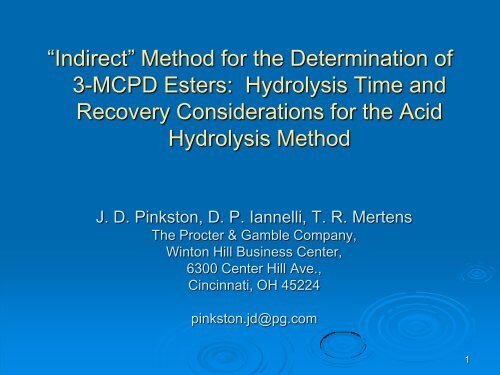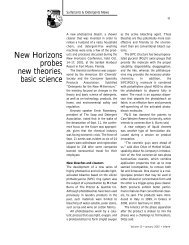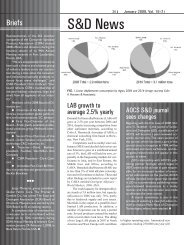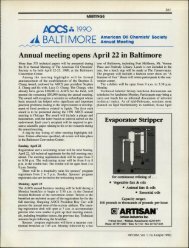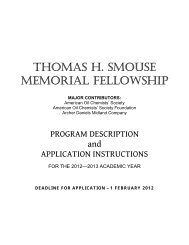3-MCPD Esters - staging.files.cms.plus.com
3-MCPD Esters - staging.files.cms.plus.com
3-MCPD Esters - staging.files.cms.plus.com
You also want an ePaper? Increase the reach of your titles
YUMPU automatically turns print PDFs into web optimized ePapers that Google loves.
“Indirect” Method for the Determination of<br />
3-<strong>MCPD</strong> <strong>Esters</strong>: Hydrolysis Time and<br />
Recovery Considerations for the Acid<br />
Hydrolysis Method<br />
J. D. Pinkston, D. P. Iannelli, T. R. Mertens<br />
The Procter & Gamble Company,<br />
Winton Hill Business Center,<br />
6300 Center Hill Ave.,<br />
Cincinnati, OH 45224<br />
pinkston.jd@pg.<strong>com</strong><br />
1
“3-<strong>MCPD</strong> esters”<br />
3-Monochloropropane-1,2-diol Fatty Acid <strong>Esters</strong><br />
3-<strong>MCPD</strong> esters (3-<strong>MCPD</strong> esterified with 1 or 2 fatty<br />
acids) are part of an emerging regulatory issue.<br />
3-<strong>MCPD</strong> esters have been reported in refined fats and<br />
oils by several groups (Svejkovská et al., 2004;<br />
Weißhaar, 2008; Zelinková , Svejkovská , Velísek, &<br />
Dolezal, 2006).<br />
2
Analytical Methods<br />
Methods can be classified in two general groups:<br />
“Indirect” methods: <strong>Esters</strong> are cleaved to a single<br />
<strong>com</strong>pound, “free 3-<strong>MCPD</strong>”, which is then<br />
derivatized and determined by GC/MS.<br />
(Divinova et al. Czech J Food Sci. 2004, 22, 182–189;<br />
Weiβhaar, Eur. J. Lipid Sci. Technol. 2008, 110, 183-186;<br />
Kuhlmann, Eur. J. Lipid Sci. Technol. 2011, 113, 335–344;<br />
Ermacora & Hrncirik, JAOCS 2012, 89, 211-217.).<br />
“Direct” methods: Major esters are determined<br />
directly via LC/TOFMS or LC/MS/MS.<br />
(Haines et al., JAOCS 2011, 88, 1-14.)<br />
3
Indirect Methods:<br />
Advantages and Drawbacks<br />
The indirect methods provide significant advantages:<br />
Straightforward determination of one species by GC/MS<br />
(widely available).<br />
Excellent LODs and LOQs.<br />
Only 2 standards (incl. 1 SIL internal standard) required.<br />
Detects all 3-<strong>MCPD</strong> esters.<br />
However, there are areas for potential improvement:<br />
Hydrolysis in presence of trace Cl - may result in inaccurate,<br />
higher results with indirect methods.<br />
Glycidol esters may be converted to 3-<strong>MCPD</strong> during<br />
sample prep --> overestimation of results.<br />
Sample preparation is tedious.<br />
Method does not differentiate between free 3-<strong>MCPD</strong> and/or<br />
different 3-<strong>MCPD</strong> esters.<br />
Details provided in Hrncirik et al., Eur. J. Lipid Sci. Technol.<br />
2011, 113, 361-367.<br />
4
Indirect Methods:<br />
Choices for Initial Cleavage of <strong>Esters</strong><br />
Base hydrolysis (methoxide):<br />
Fast & straightforward (minutes)<br />
Trace chloride and glycidyl esters can artificially increase<br />
the level of 3-<strong>MCPD</strong> esters detected.<br />
Free 3-<strong>MCPD</strong> is unstable under basic hydrolysis conditions,<br />
decreasing S/N ratios and sensitivity (Hrncirik et al. Eur. J.<br />
Lipid Sci. Technol. 2011, 113, 361-367.).<br />
Enzymatic hydrolysis:<br />
Few studies have been conducted (Hamlet & Sadd, Czech J.<br />
Food Sci. 2004, 22, 259-262.).<br />
Acid hydrolysis (H 2SO 4 in MeOH):<br />
Longer hydrolysis times (hours)<br />
Trace chloride can artificially increase the level of 3-<strong>MCPD</strong><br />
esters detected (though glycidyl esters are destroyed) .<br />
Free 3-<strong>MCPD</strong> is stable under acidic hydrolysis conditions.<br />
Acid hydrolysis method found to be more robust (Hrncirik et<br />
al., Eur. J. Lipid Sci. Technol. 2011, 113, 361-367.).<br />
5
Implementation/Development of the Acid<br />
Hydrolysis Indirect Method<br />
Key attributes of Ermacora & Hrncirik’s indirect acid<br />
hydrolysis method (JAOCS 2012, 89, 211-217):<br />
Interference of high chloride levels (when present)<br />
eliminated with simple H 2O extraction step.<br />
No interference from glycidyl esters.<br />
Authors suggest that time required for acid<br />
transesterification can be reduced from 16 h to 4 h without<br />
loss of accuracy, repeatability, or sensitivity.<br />
SIL di-ester (PP-3-<strong>MCPD</strong>-d5) re<strong>com</strong>mended as most<br />
appropriate internal standard.<br />
We found high recoveries of monoesters when this<br />
method was applied. (Accuracy for diesters was<br />
acceptable.)<br />
We have studied a variety of aspects of the method,<br />
including hydrolysis time.<br />
6
Key Points & Modifications to Acid Hydrolysis<br />
Method by Ermacora & Hrncirik<br />
Step in Method<br />
Choice of internal<br />
standard<br />
Initial water wash<br />
(optional in Ermacora &<br />
Hrncirik)<br />
Initial sample solvent<br />
for water wash<br />
Ermacora &<br />
Hrncirik*<br />
PP-3-<strong>MCPD</strong>-d5 No change<br />
Re<strong>com</strong>mended<br />
to remove Cl -<br />
P&G<br />
Retained – no change, but used for<br />
all samples.<br />
THF MTBE - better separation of oil-rich<br />
and water-rich phases in initial water<br />
wash (MTBE evaporated and THF<br />
added for subsequent steps)<br />
Hydrolysis time 4 hrs 24 hrs (improved accuracy for<br />
monoesters when I.S. is a diester)<br />
Selected ion monitoring<br />
ions<br />
m/z 147 (m/z 150<br />
for SIL internal<br />
standard)<br />
m/z 196 (m/z 201 for SIL I.S.) – m/z<br />
147 is <strong>com</strong>mon “bleed” ion for<br />
siloxane-based GC stationary<br />
phases.<br />
* - Ermacora & Hrncirik, JAOCS 2012, 89, 211-217.<br />
7
Abundance<br />
170000<br />
150000<br />
130000<br />
110000<br />
90000<br />
70000<br />
50000<br />
30000<br />
10000<br />
GC/MS Background Ions Considerations<br />
Choice of SIM Ion: m/z 147<br />
vs. m/z 196?<br />
Common background ion in<br />
siloxane-based column and<br />
septum “bleed” peaks in<br />
GC/MS<br />
77<br />
91<br />
104<br />
50 60 70 80 90 100 110 120 130 140 150 160 170 180 190 200 210<br />
m/z--><br />
147<br />
EI Mass Spectrum of the<br />
PBA Derivative of 3-<strong>MCPD</strong><br />
196<br />
M ·+<br />
8
Abundance<br />
1600<br />
1400<br />
1200<br />
1000<br />
800<br />
600<br />
400<br />
200<br />
Choice of SIM Ion, m/z 147 vs. m/z 196?<br />
0<br />
Time (min)<br />
9.92 9.96 10.00 10.04 10.08 10.12 10.16<br />
Abundance<br />
0.33 ppm (3.0 µmolar) standard Sample near LOD (~0.04 ppm (0.4 µmolar)<br />
280<br />
240<br />
200<br />
160<br />
120<br />
80<br />
40<br />
m/z 147<br />
m/z 196<br />
interferent<br />
0 9.92 9.96 10.00 10.04 10.08 10.12 10.16<br />
Time (min)<br />
Abundance<br />
1300<br />
1100<br />
900<br />
700<br />
500<br />
300<br />
100<br />
0 9.92<br />
Time (min)<br />
9.96 10.00 10.04 10.08 10.12 10.16<br />
Abundance<br />
170<br />
165<br />
160<br />
155<br />
150<br />
145<br />
140<br />
m/z 147<br />
m/z 196<br />
interferent<br />
135<br />
Time (min)<br />
9.92 9.96 10.00 10.04 10.08 10.12 10.16<br />
9
Accuracy/Recovery vs. Hydrolysis Time<br />
CSO* spiked with PP-3-<strong>MCPD</strong> at 56.2 µmolar (=6.21 ppm “free 3-<strong>MCPD</strong>”)<br />
or with P-3-<strong>MCPD</strong> at 59.9 µmolar (=6.62 ppm “free 3-<strong>MCPD</strong>”)<br />
Monoester (w/ diester IS)<br />
CSO* spiked with P-3-<strong>MCPD</strong>,<br />
PP-3-<strong>MCPD</strong>-d5 internal standard<br />
Hydrolysis Time (hr) % recovery<br />
4 225<br />
7 143<br />
16 149<br />
24 124<br />
Monoester (w/ monoester IS)<br />
CSO* spiked with P-3-<strong>MCPD</strong>,<br />
P-3-<strong>MCPD</strong>-d5 internal standard<br />
Hydrolysis Time (hr) % recovery<br />
7 116<br />
* - Fresh Refined Cotton Seed Oil,<br />
total 3-<strong>MCPD</strong> esters: 3.29 µmolar<br />
(=0.36 ppm “free 3-<strong>MCPD</strong>”)<br />
Diester (w/ diester IS)<br />
CSO* spiked with PP-3-<strong>MCPD</strong>,<br />
PP-3-<strong>MCPD</strong>-d5 internal standard<br />
Hydrolysis Time (hr) % recovery<br />
4 108<br />
7 109<br />
16 115<br />
24 115<br />
Recoveries acceptable at any<br />
time for monoester with<br />
Rate of hydrolysis of<br />
monoester IS, and for diester<br />
monoester faster than that of<br />
with diester IS.<br />
diester, yielding high recovery<br />
for monoester at shorter<br />
hydrolysis times.<br />
10
Abundance<br />
310<br />
300<br />
290<br />
280<br />
270<br />
260<br />
250<br />
240<br />
Limit of Quantitation/Limit of Detection<br />
Selected ion monitoring (SIM)<br />
chromatogram of lowest standard<br />
m/z 196.0<br />
LOQ = 0.11 ppm<br />
S/N ≈ 8<br />
110 pg injected, splitless injection<br />
Estimated LOD (S/N ≈ 3) at 0.04 ppm<br />
11.90 11.95 12.00 12.05 12.10 12.15 12.20 12.25 12.30<br />
Time (min)<br />
11
m o l<br />
µ<br />
60<br />
58<br />
56<br />
54<br />
52<br />
50<br />
48<br />
46<br />
44<br />
Precision<br />
Protocol for measuring repeatability & intermediate<br />
precision:<br />
7 aliquots of working reference material vegetable oil<br />
prepared on 3 separate days by 1 analyst. Each sample (1<br />
per aliquot) determined in triplicate.<br />
Overview:<br />
A B C A B C A B C A B C A B C A B C A B C A B C A B C A B C A B C A B C A B C A B C A B C A B C A B C A B C A B C A B C A B C injection<br />
1 2 3 4 5 6 7 1 2 3 4 5 6 7 1 2 3 4 5 6 7 aliquot<br />
1 2 3 day<br />
12
Variability by <strong>com</strong>ponent:<br />
Precision - Results<br />
Component % of Total Variability<br />
Day-to-day 66.2<br />
Injection-to-injection (within<br />
aliquot)<br />
31.6<br />
Aliquot/sample prep (within day) 2.2<br />
Instrumental repeatability:<br />
RSD: 3.6% (from 21 sets of triplicate injections)<br />
Aliquot/sample prep repeatability:<br />
RSD: 0.94% (from 3 sets of 7 aliquots)<br />
Intermediate precision, day-to-day:<br />
RSD: 5.2% (from 3 days)<br />
Intermediate precision, total (1 analyst):<br />
RSD: 6.3%<br />
13
Analyte response/Internal standard response<br />
7.000<br />
6.000<br />
5.000<br />
4.000<br />
3.000<br />
2.000<br />
1.000<br />
-1.000<br />
Linearity & Range<br />
Calibration Curve for Total 3-<strong>MCPD</strong> <strong>Esters</strong>, Acid Hydrolysis<br />
y = 0.0572x - 0.0028<br />
R² = 0.9999<br />
0.000<br />
0.0 20.0 40.0 60.0 80.0 100.0 120.0<br />
Standard Concentration (µmolar)<br />
14
Update on Direct Method<br />
We provided an update on our direct LC/MS/MS method for<br />
3-<strong>MCPD</strong> esters at the last AOCS national meeting<br />
(Pinkston & Stoffolano, 102 nd AOCS National Meeting and<br />
Exposition, May 1-4, 2011, Cincinnati, OH).<br />
Our method provided some advantages over a similar<br />
LC/TOFMS method described by Haines et al. (JAOCS<br />
2011, 88, 1-14.), notably little need for instrument<br />
cleaning.<br />
However, unresolved interferences required the use of a<br />
standard addition method (with tedious sample<br />
preparation).<br />
We are investigating a simple silica SPE step which may<br />
remove much of the interferent.<br />
We are working to develop a more standard analytical<br />
method incorporating the SPE cleanup with LC/MS/MS.<br />
15
Summary<br />
We have implemented an indirect method for total 3-<br />
<strong>MCPD</strong> esters in vegetable oils in our laboratory based<br />
upon the acid hydrolysis method of Ermacora & Hrncirik.<br />
Notable differences we re<strong>com</strong>mend:<br />
Use of MTBE as initial sample solvent for water wash.<br />
24-hr hydrolysis time<br />
GC/MS SIM ion: m/z 196<br />
Acknowledgements<br />
Thanks to Shuo Wang, Jim Jordan, Pete Stoffolano,<br />
Jaque Heisey, Katrin Schutte, Dick DePalma, and<br />
Debbie Ewald for their contributions.<br />
16


